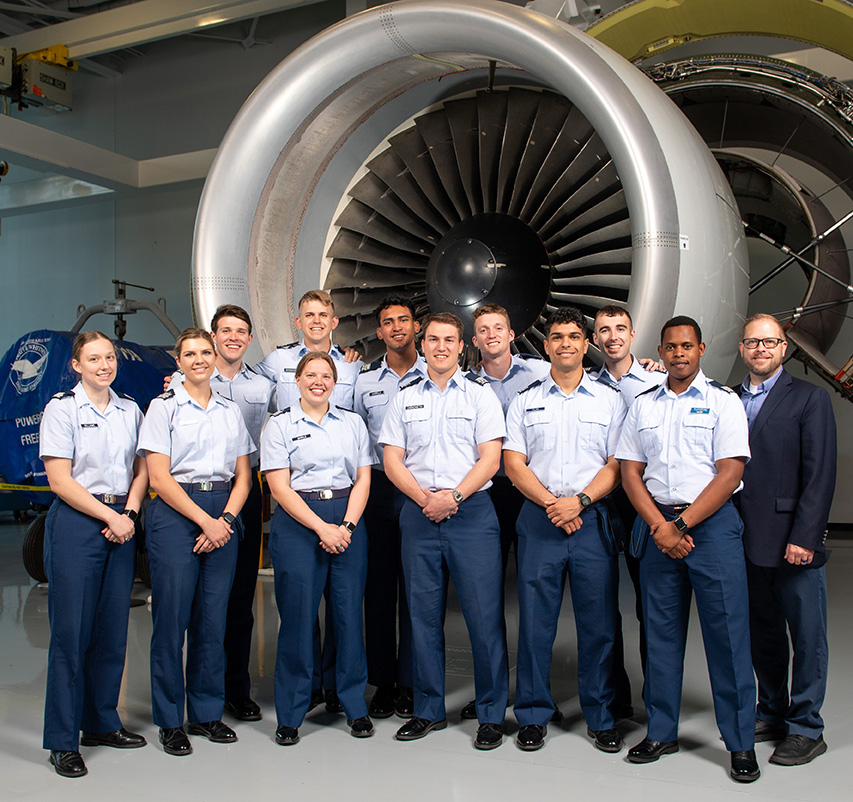News: Fly, fight and win
Pratt & Whitney fosters future leaders
For nearly two decades, cadets from the U.S. Air Force Academy have traveled to Connecticut to learn from some of the top minds in engineering at Pratt & Whitney. This annual trip allows cadets to present their capstone propulsion projects — highly detailed engine designs that require over a year's worth of careful experimentation, research, and planning.
This spring, two teams of cadets from the Department of Aeronautics presented their propulsion projects to a panel of seven Pratt & Whitney engineers. They covered their initial design process, cost estimates, and details of their engine's performance requirements. Throughout this design process, the cadets strengthened their communication skills and learned to depend on each other.
“Just like an engine’s components rely on each other, we are working together as a team,” said Cadet 1st Class Chloe Surrency, who graduates this month and is set to attend graduate school before beginning pilot training at Columbus Air Force Base, Mississippi. “The biggest lesson in leadership I learned from this experience was understanding how to think proactively. In previous engineering schoolwork, they provided us with the question, and you look for the solution. With this design process, we had to anticipate both the questions and the answers. Being able to clearly define the problem is very important to ensure you find solutions that work for everyone.”
After their presentations, cadets toured Pratt & Whitney's engine production facilities in Middletown, Connecticut, where they witnessed what goes into assembling, testing, and preparing an F135 engine for shipment. The facilities feature high-tech assembly lines, engine test cells, and advanced technologies that work together to produce the world's most powerful fighter engine.
"The education offered by the U.S. Air Force Academy to these cadets is world-class," said Christopher Monnes, manager of Pratt & Whitney F135 Business Operations and Advocacy and the host of the annual event. “Seeing large jet engine assembly and testing firsthand at our Middletown Product Delivery Center provides an industry perspective and experience that supplements what the cadets learn in the classroom. It is something I hope they will always remember — long into their Air Force and service careers."

Powering Collaborative Combat Aircraft: the future of air superiority
This year, cadets were challenged to create an engine concept for a Collaborative Combat Aircraft. As part of the U.S. Air Force’s wider Next-Generation Air Dominance program, CCA drones will integrate autonomous unmanned aircraft alongside fifth- or sixth-generation manned fighter aircraft.
Working in a “family of systems,” CCAs will form the backbone of the U.S. Air Force’s future fleet, implementing cutting edge technology for agile combat operations. This makes them an exceptionally relevant focus for the cadets’ designs, representing a new era in air warfare.
“Each year, the aircraft and propulsion design faculty identify a project that is of interest to the Air Force,” said Professor Devin O’Dowd, associate professor in the Department of Aeronautics at the U.S. Air Force Academy. “When the CCA design was selected, there was very little public information. Although the Air Force has since publicly identified requirements for a CCA engine, the cadets designed an engine based on what faculty believed might be desired. The motivation for learning is greatly enhanced when cadets design an engine based on a real-world need for the military service that they are a part of.”
The timeliness of the cadets’ propulsion project this year is underscored by the U.S. Air Force’s recent CCA vendor down select in late April, going from five contractors to two. It is forecasted that future CCA increments may offer more advanced capabilities. Although the cadets’ designs are theoretical, they provide a solid foundation for understanding the development of a real-world CCA engine.
After both groups shared their design projects, they received real time feedback from the panel of Pratt & Whitney engineers.
“As an engineer at Pratt & Whitney, I found it truly special to share feedback and industry best practices with the cadets on their engine designs,” said Julie DiGiacomo, associate director of Project Engineering at Pratt & Whitney. “It was interesting to see that each team had different approaches to achieve their designs, and that both teams found importance in stating clear requirements to achieve their most competitive designs in cost, range, and efficiency. I was very impressed by the professionalism of the young men and women and inspired by their post-graduation plans.”
A legacy of supporting propulsion research and innovation at the Academy
The relationship between the Academy and Pratt & Whitney can be traced back to one influential Pratt & Whitney engineer, Frank Gillette. Gillette is widely known as the “Father of the F119 Engine,” the stealthy, supercruising powerplant for the F-22 Raptor.
For decades, Gillette would make annual trips to the Academy, mentoring cadets, and faculty in the Department of Aeronautics, and teaching them about thermodynamic theory and its connection to modern jet engines. It was his strategic planning that started the tradition of cadets traveling to Pratt & Whitney to present their propulsion projects. While he no longer makes this journey, his legacy lives on in the establishment of a fully funded, Frank Gillette Propulsion Researcher position at the Academy. Dr. Charles Wisniewski has held this position since its inception in 2015. Research is currently focused on various propulsion-related efforts, including quiet propellers, synthetic fuels, and thrust augmentation.
“As a former mentee of Frank Gillette, I experienced firsthand the passion he has when working with early career professionals,” said Tom Prete, vice president of Engineering for Pratt & Whitney Military Engines. “Our partnership with the Air Force has resulted in huge leaps forward in aviation. As Pratt & Whitney approaches its 100-year anniversary, our relationship becomes ever more critical as we navigate highly contested air spaces. These cadets are building upon Frank Gillette’s legacy and will be leading the charge for the next 25 years protecting our freedom.”

